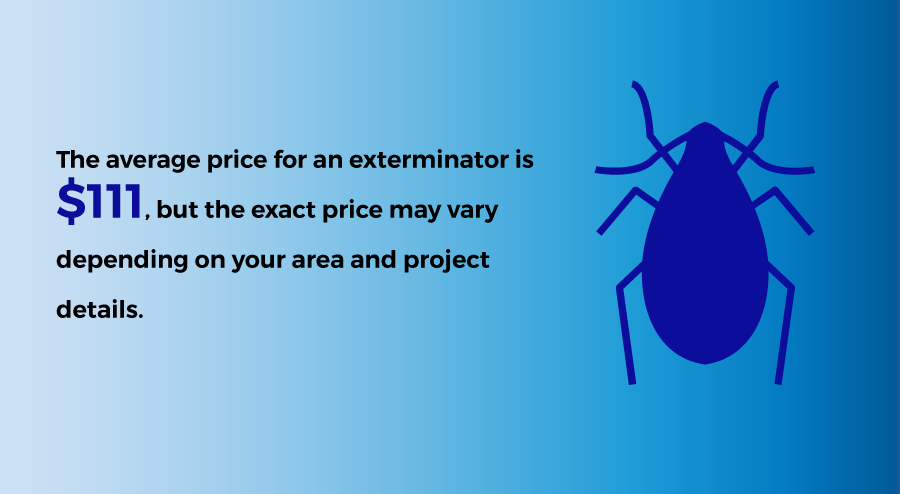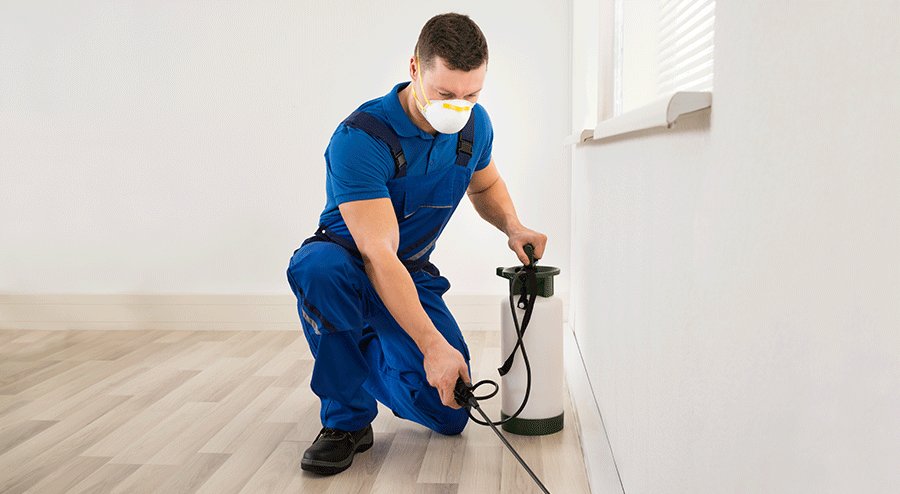Read and Learn More About Pests
Pest Control PricingPest Control Pricing
Sometimes a small pest problem goes unnoticed until it becomes too large to manage. By the time you’re ready to stock up on bug spray or traps, you may find that commercial products only contain the raiders temporarily. With an exterminator visit costing the same amount that would feed one’s family at a nice restaurant, not every homeowner is ready to whip out a checkbook and take off work for professional servicing. When is professional pest control really called for?
A specialist can be your best investment in both money and time if you can’t keep an infestation under control. You don’t just want these invaders out of your view – you want them off your property. With safety being everyone’s top priority, pests like brown recluse and black widow spiders, scorpions, and fire ants are dangerous. Pets and very young children may not know to avoid them, and they pose a liability issue for visitors in your home.
The greatest problems often come from the insects that are out of sight until serious trouble occurs. Raccoons tear up insulation in areas like crawl spaces. Wood-boring insects like termites consume furniture and the woodbeams holding up your home. They can damage your house’s structure and render it unlivable.
National Average Cost of Pest Control
A typical range for pest control in the United States is $108-$273.
- National Average Cost of Pest Control ($177)
- Low End ($50)
- High End ($529)
(Source: HomeAdvisor)
Cost and Frequency
If you spot pests for the first time, you may be able to call in the professionals for a one-time extermination. But return visits from your unwanted guests call for a treatment plan. The investment depends the type of pest, your home’s size, and the frequency of the visits which your professional deems necessary. The more often your home is treated, the easier it will be to combat any future signs of infestation. If you live in an insect-prone climate or in a home that has been infested in the past, ongoing treatment is prudent.
When researching prices, be sure you’re clear on whether the quotes are for an initial visit, a one-time visit only, or a monthly, semimonthly, or quarterly, or semiannual treatment. Many providers even offer an on-site estimate for free after they assess the level of infestation and necessary next steps. The typical one-shot deal for pest control treatment is around $300 to $550. This one-time cost is higher than most listed averages because most of the time is taken to gauge the infestation and locate nests and points of entry.
You are likely to spend between $60 and $225 total on an exterminator.

(Source: Thumbtack, updated October 1st, 2017)
Within a treatment package, however, that first assessment usually costs around $180. This cost is part of an agreement to periodic visits. Some contracts stipulate that if you have issues between visits, then interim treatments will be provided for free. Be sure to ask about such a situation. In any case, expect your first visit to come at a higher cost than the follow-ups.
Typical One-Shot Deal for Pest Control Treatment
Subsequent periodic visits can take place monthly at around $40-45, semimonthly at around $50-60, or quarterly in the neighborhood of $100-300. Most quotes are given a typical 1,500 square foot house. Some exterminators charge an extra $25 per 1,000 square feet over 1,500. The size of the home or location will directly affect the overall cost for services. Larger properties increase technicians’ work time required of the workers as well as the amount of chemicals, products and materials required to treat the area.
A large infestation or more extensive damage will increase the time and manpower needed to finish the job. Chemicals and procedures utilized can also affect the cost, as can the inherent danger. Some exterminators offer preliminary pricing at 45-minute increments for bedbugs (typically $75), bees ($95), and general pest control around $95. Be sure to discuss this up front at the initial inspection. One-time wildlife removal often prices at $125, whereas a treatment plan runs between $475-575. This generally includes setting traps, transporting the animals back into the wilderness, three follow-up visits, and steps to curb future infestation.
Ongoing Treatment
 Some pest problems can be resolved without any future follow-up. With wildlife like squirrels and raccoons, the key is in removing food sources and blocking access to nesting areas and points of entry. Sometimes a local beekeeper who wants the hive may even remove it for free. But for other pests, a one-time visit is not realistic. Ants, roaches, spiders, termites, ticks, fleas, and rodents, and fleas are difficult to keep away from a nearby food source, even with a thorough treatment and cleanup.
Some pest problems can be resolved without any future follow-up. With wildlife like squirrels and raccoons, the key is in removing food sources and blocking access to nesting areas and points of entry. Sometimes a local beekeeper who wants the hive may even remove it for free. But for other pests, a one-time visit is not realistic. Ants, roaches, spiders, termites, ticks, fleas, and rodents, and fleas are difficult to keep away from a nearby food source, even with a thorough treatment and cleanup.
Climate can also affect the infestation issue. Warm areas drive pests to cool shelter. Cold climates prompt others to warm environments. In both of these cases, a pest control service contract is worth the investment.
If your home is in a rural area or outside of the company’s standard service territory, this may mean travel fees. Sometimes service providers charge travel fees to cover additional time, mileage and transportation costs. Consider this expense when you are choosing the frequency of an ongoing treatment package.
The Hidden Cost Of Pests
Most people won’t choose to hire a professional if they think they can easily solve the problem with a spray or trap from the neighborhood drugstore. But if the pests are seen again, the best next move is to pick up a phone. Insects can lay eggs and fecal matter throughout your property, eat through your clothing, and spread germs and bacteria. And some serious issues are specific to certain pests:
 Rodents are a source of Hantavirus, rabies, salmonella, and foot-and-mouth disease. Mice in particular can cause untold amounts of damage to your food, leaving a scented trail of urine behind them. Their fur and body waste contaminates everything with which it comes into contact, including containers of cereals and grains. A quarter of all fires were caused by mice and rats chewing on electrical insulation. This damage can rise to hundreds of thousands of dollars.
Rodents are a source of Hantavirus, rabies, salmonella, and foot-and-mouth disease. Mice in particular can cause untold amounts of damage to your food, leaving a scented trail of urine behind them. Their fur and body waste contaminates everything with which it comes into contact, including containers of cereals and grains. A quarter of all fires were caused by mice and rats chewing on electrical insulation. This damage can rise to hundreds of thousands of dollars.

Carpenter Ants carve away at damp wood and grow and farm molds and other fungi to consumer. Their galleries can significantly weaken the structure of a home. Any outside stress like winds or inclement weather can trigger a collapse. It is common for carpenter ant damage to set a homeowner back $6,000 to $10,000.
![]()
Termites eat away at estimated $5 billion worth of property damage each year – exceeding the cost of floods, fires, earthquakes, tornados, and hurricanes together. Termite infestations often cause thousands of dollars in a single home for repairs.
For certain pests, a second pest species is a package deal. A rodent infestation in a home usually goes hand-in-hand with a flea infestation. Wolf spiders are also found near cockroaches. Delaying the treatment of one or the other infestation compounds the problem and the time involved in cleanup and treatment.
Another issue to give homeowners pause is the rapid reproduction rate of many pests. A single female mouse produces 5 to 10 litters per year, with 5 to 6 offspring each.
Litters a Single Female Mouse Can Produce Per Year
These babies can reproduce after 30 days, totaling 25 to 60 mice (300 to 720 mice in a year’s time). A female cockroach produces 4-8 capsules of 30-48 eggs in her lifetime. With roaches reaching maturity in 40 to 125 days, a residence can have 1,500 roaches in five weeks – 18,000 in the course of a year.
It is quicker, easier, and cheaper to eradicate pests by stepping in before they have had time to reproduce, sustain damage, or create a health issue. Once rodents breed or insect colonies have set up shop, you will have a costly problem on your hands.
The Price Of Your Peace Of Mind
Living in heavily infested homes, or even moderately infested homes for an extended period of time, can take a psychological toll on a family. Insects and arachnids suddenly popping out of nowhere can unsettle on normally fearless individuals. Constantly swatting flies or flicking off barely visible bugs can easily cause hypervigilance and the anxiety that a home is never clean enough. In particular, more and more research links bedbug infestations with mental health issues like insomnia to depression.
Pest Control Maintenance Plans
 A contract may have options for monthly, semi-monthly, quarterly, or even six months. Once a thorough assessment has taken place and pests and their sources have been addressed one way or another, follow-ups are all about maintenance. Monthly treatments will set a consumer back $40 to $45. Semi-monthly applications may range from $50 to $60. Some companies have been known to provide a three-treatment pricing package, with a larger fee around $150 for the first visit and $80 two subsequent treatments. Compare prices among local companies and consider the needs of your specific property.
A contract may have options for monthly, semi-monthly, quarterly, or even six months. Once a thorough assessment has taken place and pests and their sources have been addressed one way or another, follow-ups are all about maintenance. Monthly treatments will set a consumer back $40 to $45. Semi-monthly applications may range from $50 to $60. Some companies have been known to provide a three-treatment pricing package, with a larger fee around $150 for the first visit and $80 two subsequent treatments. Compare prices among local companies and consider the needs of your specific property.
The best time to find a pest control professional is before you’re sure you need one. Begin researching local exterminators when you first spot a stray roach or your first trail of ants. Termite swarms in spring, however, are a time-sensitive urgency. Waiting until it’s an undeniable problem will cost more in terms of money, time, energy, and your health and well-being.
More Pest Control Solutions
Read Reviews
Read reviews by other customers like you.
Research
Tips and articles to help you select a pest control provider.
Find Providers
Find a qualified pest control provider in your area.

